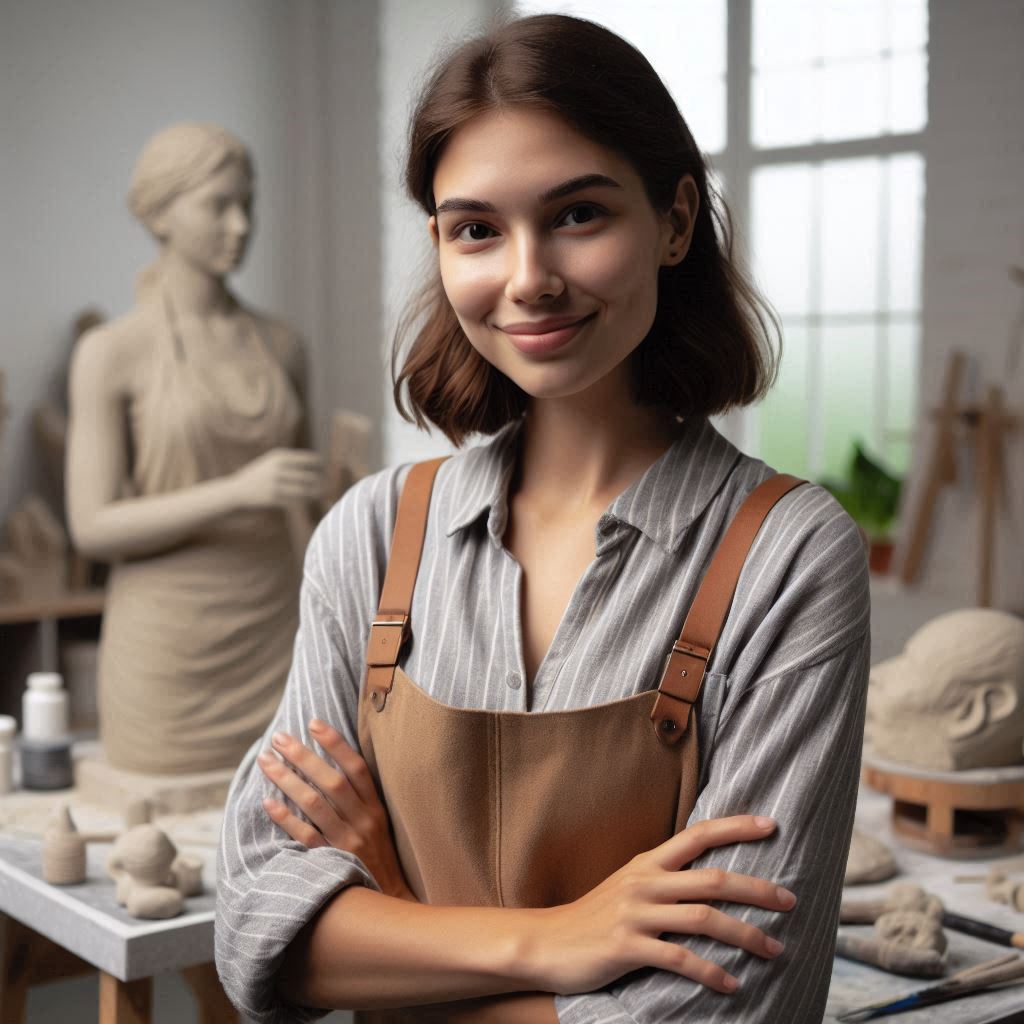Introduction
Grants and funding opportunities for sculptors play a crucial role in supporting artists to pursue their creative endeavors.
These resources provide financial assistance that can make a significant impact on a sculptor’s career and work.
Grants and funding are essential in the art world as they enable sculptors to explore new techniques, materials, and concepts.
Receiving grants can propel a sculptor’s career by allowing them to focus on creating art without the burden of financial constraints.
It gives artists the freedom to take risks, experiment, and push boundaries in their work.
Types of Grants Available for Sculptors
Different types of grants available for sculptors
There are various types of grants available for sculptors, including artist grants, project grants, and residency grants.
Artist grants are typically given to individual sculptors to support their artistic endeavors and projects.
Project grants are awarded to sculptors for specific projects or exhibitions they are working on.
Residency grants provide sculptors with the opportunity to work in a dedicated space for a period of time.
Eligibility Criteria for Each Type of Grant
Artist grants often require applicants to provide a portfolio of their work and a detailed proposal outlining their artistic vision.
Project grants may have specific requirements related to the scope and scale of the project, as well as a timeline for completion.
Residency grants typically require applicants to demonstrate a strong commitment to their artistic practice and a desire to engage with a new community or environment.
Examples of Well-Known Organizations Offering Grants to Sculptors
- The Pollock-Krasner Foundation provides grants to sculptors who are in need of financial assistance to further their artistic careers.
- The Joan Mitchell Foundation offers grants to sculptors in recognition of their artistic talent and potential for growth.
- The Sculptor Foundation supports emerging and established sculptors through grants, awards, and residencies to foster artistic development.
- The National Endowment for the Arts provides funding opportunities for sculptors through various grant programs, supporting a wide range of artistic projects.
- The Andy Warhol Foundation for the Visual Arts offers grants to sculptors who demonstrate a commitment to experimentation and innovation in their work.
Overall, there are a variety of grants and funding opportunities available to sculptors, each with its own set of criteria and requirements.
By researching and applying to these opportunities, sculptors can access the financial support they need to continue creating and sharing their art with the world.
Read: Balancing Creativity and Commerce in Art Careers
How to Find Grant Opportunities
Tips on how sculptors can research and find grant opportunities
Sculptors seeking funding can find numerous grant opportunities with focused research.
Start by identifying specific grant types that suit your artistic needs.
Look for grants aimed at individual artists, public art projects, or community initiatives.
Each type has unique criteria, so align your search accordingly.
Websites, resources, and databases where sculptors can search for grants
Utilize online databases dedicated to artist grants.
Transform Your Career Today
Unlock a personalized career strategy that drives real results. Get tailored advice and a roadmap designed just for you.
Start NowWebsites like Grants.gov and Caf‘ list federal and regional funding opportunities.
Check ArtDeadline.com for timely updates on grants and residencies.
The Foundation Center offers extensive resources on funding sources and grant-writing tips.
These platforms can streamline your search and connect you to potential funding.
Don‘t overlook local resources. Many cities have arts councils that provide funding opportunities for local artists.
Visit your local library to access grant-writing books and guides.
Attend workshops on grant writing, as they often share valuable insights and tips.
Encouraging sculptors to network with other artists and attend events to discover grant opportunities
Networking plays a crucial role in discovering grant opportunities.
Connect with other artists through social media platforms like Instagram and Facebook.
Join artist groups and forums to share experiences and advice on funding.
Attend art exhibitions, gallery openings, and community events to meet fellow sculptors and art advocates.
Engage in conversations about funding.
These interactions can lead to referrals and insights on hidden grant opportunities.
Consider volunteering for arts organizations to expand your network and gain insider knowledge.
Finally, stay organized during your research.
Create a spreadsheet to track grant deadlines, requirements, and submission guidelines.
This approach ensures you never miss an opportunity.
With diligent research and a proactive networking strategy, sculptors can discover valuable grant opportunities to support their creative endeavors.
Read: Funding Your Glass Art Projects
Tips for Writing a Strong Grant Proposal
When applying for grants as a sculptor, writing a strong grant proposal is key to securing funding for your projects.
Transform Your Career Today
Unlock a personalized career strategy that drives real results. Get tailored advice and a roadmap designed just for you.
Start NowHere are some tips to help you craft a compelling proposal:
Follow the Guidelines Carefully
- Read and understand all the requirements and instructions provided by the grant organization.
- Make sure to address all the criteria and provide all the necessary documentation.
- Follow the formatting guidelines for the proposal to ensure clarity and professionalism.
Showcase Your Unique Style, Vision, and Experience
- Highlight what sets your work apart from others in the field.
- Explain your artistic vision and how it aligns with the grantor’s mission or goals.
- Share your experience, qualifications, and achievements as a sculptor.
Develop a Well-Thought-Out Project Plan and Budget
- Clearly outline your project goals, objectives, and timeline.
- Explain the significance and impact of your project within the community or the art world.
- Create a detailed budget that covers all expenses related to the project, including materials, labor, and any other costs.
Remember that grant organizations receive numerous proposals, so it’s essential to make yours stand out.
By following these tips and putting in the effort to create a strong and compelling grant proposal, you increase your chances of securing funding for your sculpting projects.
Read: Art and Design Portfolios: Creating a Standout

Exploring Alternative Funding Sources
Alternative funding sources for sculptors
When it comes to funding your sculpting projects, grants are not the only option available.
There are alternative funding sources that sculptors can explore to finance their work.
Crowdfunding Platforms
Platforms like Kickstarter and Indiegogo allow artists to raise money from a large number of people.
- Pros: Can reach a wide audience, low barrier to entry, direct connection with supporters.
- Cons: Need to meet fundraising goal to receive funds, platform fees, competition with other projects.
Sponsorships
Seeking sponsorships from businesses, galleries, or individuals can provide financial support.
- Pros: Potential for ongoing partnerships, access to resources, increased exposure.
- Cons: Dependence on sponsor’s interests, may require giving up creative control.
Pros and Cons of Different Funding Options
Each funding option comes with its own set of advantages and disadvantages that sculptors should consider before making a decision.
Grants
- Pros: Typically no repayment required, prestigious recognition, support for artistic development.
- Cons: Highly competitive, lengthy application process, restrictions on how funds can be used.
Crowdfunding
- Pros: Access to a large pool of potential donors, creative control over project.
- Cons: Need to actively promote the campaign, time-consuming to manage, platform fees.
Sponsorships
- Pros: Financial support without repayment, potential for ongoing partnerships.
- Cons: Dependence on sponsor’s interests, possible loss of creative control.
Encouraging Creative Approaches to Funding
As a sculptor, thinking outside the box when it comes to funding can open up new opportunities and collaborations.
Consider combining different funding sources to create a diverse financial support system for your projects.
Build relationships with potential sponsors or donors by showcasing your work and communicating your artistic vision effectively.
Attend networking events, art fairs, and exhibitions to connect with individuals or organizations that may be interested in supporting your work.
Remember that finding funding for your sculpting projects is a creative process in itself, so don’t be afraid to take risks and try new approaches.
Read: Glass Art Courses: What to Expect
Common Mistakes to Avoid When Applying for Grants
Common mistakes that sculptors make when applying for grants
Lack of Research
- Skipping thorough research on grant requirements can lead to disqualification.
- Research each grant thoroughly to ensure your project aligns with the grant’s goals.
Not Following Guidelines
- Ignoring guidelines is a common mistake that can result in rejection.
- Pay attention to all instructions and be sure to follow them explicitly.
Missing Deadlines
- Late submissions are often automatically disqualified from consideration.
- Set reminders and start the application process well in advance to avoid missing deadlines.
Unclear Project Proposal
- Submitting a vague or unclear project proposal can harm your chances.
- Clearly articulate your project goals, timeline, and budget in your proposal.
Lack of Professionalism
- Sloppy applications or unprofessional communication can hurt your chances.
- Proofread your application, ensure all documents are neat, and use professional language.
Tips to Avoid These Mistakes and Increase Your Chances of Success
- Conduct thorough research on each grant opportunity before applying.
- Pay close attention to guidelines and follow them meticulously.
- Mark deadlines on your calendar and start the application process early.
- Clearly articulate your project proposal, including goals, timeline, and budget.
- Maintain professionalism throughout the application process, from communication to presentation.
Importance of Following Guidelines and Deadlines
- Following guidelines and deadlines is crucial for a successful grant application.
- Adhering to guidelines shows respect for the grant provider and can increase your chances of approval.
- Missing deadlines or failing to follow instructions may result in immediate disqualification.
Success Stories of Sculptors Who Received Grants
Inspiring success stories of sculptors who received grants and funding for their projects
Grants and funding opportunities can make a significant difference in a sculptor’s career.
Here are some inspiring success stories of sculptors who received grants:
- John Smith: John Smith, a talented sculptor, received a grant to create a public art installation in his community.
This grant not only helped him financially but also provided him with recognition and exposure. - Emily Davis: Emily Davis, a young sculptor, was awarded a grant to attend a prestigious artist residency program.
This opportunity allowed her to work alongside renowned artists and expand her network in the art world. - Carlos Martinez: Carlos Martinez, an emerging sculptor, received a grant to participate in an international sculpture symposium.
This experience broadened his perspective and inspired him to explore new techniques and materials in his work.
How Grants Have Helped These Artists
Grants have played a crucial role in helping these sculptors further their careers and achieve their artistic goals.
Here’s how grants have positively impacted their work:
- Financial Support: Grants provide financial assistance to sculptors, enabling them to cover production costs, studio rent, materials, and other expenses associated with creating art.
- Professional Development: Grants often come with opportunities for professional development, such as artist residencies, workshops, and mentorships, which help sculptors enhance their skills and knowledge.
- Exposure and Recognition: Grants can elevate a sculptor’s profile within the art community, attracting attention from galleries, collectors, and critics, leading to increased visibility and opportunities for exhibitions and collaborations.
- Artistic Freedom: By receiving grants, sculptors are granted the freedom to experiment, take risks, and explore new ideas without the constraints of commercial demands, allowing them to push the boundaries of their creativity.
The Positive Impact of Grants on a Sculptor’s Work
Overall, grants can have a transformative effect on a sculptor’s artistic development and practice.
Transform Your Career Today
Unlock a personalized career strategy that drives real results. Get tailored advice and a roadmap designed just for you.
Start NowThey provide a lifeline of support that empowers sculptors to pursue their passion, innovate, and contribute to the cultural landscape.
Through grants, sculptors can realize their artistic vision, connect with diverse audiences, and leave a lasting legacy through their work.
Uncover the Details: How to Get Your First Exhibition Design Job
Conclusion
Sculptors have access to various grants and funding opportunities to support their artistic endeavors.
These resources can provide financial assistance for projects, residencies, and exhibitions.
It is essential for sculptors to actively seek out these opportunities to advance their careers and gain recognition in the art world.
Grants and funding opportunities play a crucial role in enabling sculptors to create new works, attend workshops, and participate in international exhibitions.
They offer financial support that can help artists cover the costs of materials, travel, and exhibition fees.
It is important for sculptors to be proactive in researching and applying for grants and funding opportunities.
By taking advantage of these resources, artists can not only realize their artistic visions but also build a sustainable career in the arts.
Sculptors should view grants and funding opportunities as valuable tools that can help them achieve their artistic goals and aspirations.
These resources can provide the necessary financial backing to bring their ideas to life and reach a wider audience.
In summary, grants and funding opportunities are instrumental in supporting sculptors and enabling them to pursue their artistic dreams.
It is crucial for artists to explore these avenues, seize opportunities, and carve a path towards success in the competitive field of sculpture.
[E-Books for Sale]
The Big Book of 500 High-Paying Jobs in America: Unlock Your Earning Potential
$19.99 • 500 High-Paying Jobs • 330 pages
Explore 500 high-paying jobs in America and learn how to boost your career, earn more, and achieve success!
See All 500 High-Paying Jobs of this E-Book
1001 Professions Without a Degree: High-Paying American Jobs You Can Start Now
$19.99 • 1001 Professions Without a Degree • 174 pages
Discover 1001 high-paying jobs without a degree! Unlock career tips, skills, and success strategies for just $19.99!



